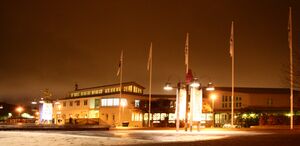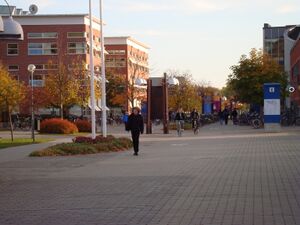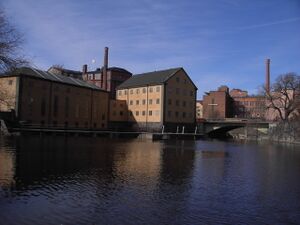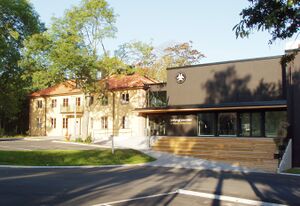Linköping University
(University) | |
|---|---|
 | |
| Formation | 1975 |
| Type | |
| Emphasises dialogue with the surrounding business sphere and the community at large, both in terms of research and education | |
Linköping University (Linköpings universitet, LiU) is a public university in Linköping, Sweden. Linköping University was granted full university status in 1975 and is now one of Sweden's larger academic institutions.[1] Education, research and PhD training are the mission of four faculties: Arts and Sciences, Educational Sciences, Medicine and Health Sciences, and the Institute of Technology.[2] In order to facilitate interdisciplinary work, there are 12 large departments combining knowledge from several disciplines and often belonging under more than one faculty.[3] Linköping University emphasises dialogue with the surrounding business sphere and the community at large, both in terms of research and education.[4] In 2018, Linköping University was home to 32,000 students and 4,000 employees.[5]
Contents
History
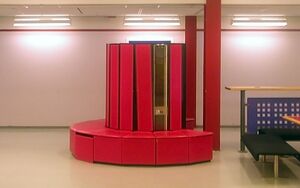
The origins of Linköping University date back to the 1960s. In 1965, The Swedish National Legislative Assembly (Riksdag) decided to locate some programmes within the fields of technology and medicine to Linköping. In 1967 a branch of Stockholm University was placed in Linköping, offering education within humanities, social sciences and natural sciences. Two years later a unit for medical training and the Institute of Technology were established. In 1970 all activities were brought together in three faculties within the Linköping University College: the Faculty of Arts and Sciences, the Faculty of Medicine and the Institute of Technology. Linköping University was established in 1975.
In 1977 former teacher training colleges in Linköping and Norrköping were transferred to Linköping University and in 1986 the Faculty of Health Sciences was formed, based on the faculty of medicine and regional funded education in health care professions. In 1997 a campus was opened in the neighbouring city of Norrköping. The renowned Carl Malmsten School of Furniture (Malmstens Linköping University) has been part of Linköping University since 2000. After almost 60 years at the city centre, the school moved into new premises on the outskirts of Stockholm in 2009.[6]
In June 2017 the gender studies faculty arranged a workshop where humans could speed date plants and do yoga.[7][8][9]
Research
Linköping University pursues research and postgraduate studies within the fields of technology, medicine, and humanities, natural, educational, social and behavioural sciences. It is particularly noted for its openness to multidisciplinary research and, in 1980, was the first Swedish university to introduce interdisciplinary thematic research at the Faculty of Arts and Sciences, and a cross-subject, interdisciplinary perspective in graduate schools for PhD students.[10]
Linköping University receives research grants from the Swedish government within five strategic research areas: IT and mobile communication, materials science, security and emergency management, e-Science and transport research.<refhttps://liu.se/en/article/strategiska-forskningsomraden </ref>
Notable faculty
- Gerhard Andersson, Professor of Clinical Psychology
- Anders Blomqvist, Professor of Pain Research
- Christian Berggren, Professor of Industrial Management
- Magnus Berggren, Professor of Organic Electronics
- Per-Erik Ellström, Professor of Education
- Fredrik Gustafsson, Professor of Sensor Informatics
- Lars Hultman, Professor of Materials Science
- Olle Inganäs, Professor of Organic Electronics
- Lennart Ljung, Professor of Control Theory
- Nina Lykke, Professor of Gender Studies
- Jan-Ove Palmberg, Professor of Mechanical Engineering
- Jerker Rönnberg, Professor of Psychology
- Carl-Ulrik Schierup, Professor of Ethnicity
- Stefan Thor, Professor of Biology
- Anthony Turner, Professor of Biosensors and Bioelectronics
Notable former faculty
- Stig Hagström, Professor Emeritus of Materials Science
- One of the founders of Linköping University
- Leading researcher in materials science
- Harold Lawson, former Professor of Telecommunications and Computer Systems
- Credited with the invention of the pointer in programming languages
- ACM Fellow
- Ingemar Lundström, Professor Emeritus of Applied Physics
- Leading researcher in biosensors and chemical sensors
- Chairman for the Nobel Committee for Physics
- Hans Rådström, former Professor of Applied Mathematics
- Mathematician who made many important contributions
- Erik Sandewall, Professor Emeritus of Computer Science
- Leading researcher in artificial intelligence
- AAAI Fellow
- Vladimir Mazya, Professor Emeritus of Mathematics
- Known for his work on Sobolev spaces
- Åke Öberg, Professor Emeritus of Biomedical Engineering
- Leading researcher in circulatory physiology, bio-optics, biomedical instrumentation, sensors and clinical engineering
Notable alumni
- Carl-Henric Svanberg, Chairman of Volvo, former CEO of Ericsson and chairman of BP
- Nashwa Eassa
- Henry Radamson, Swedish professor of microelectronics and semiconductor, member of Chinese Academy of Science
- Anders Flodström, professor of Materials physics at the Royal Institute of Technology, former Rector of the Royal Institute of Technology, former University Chancellor of Sweden and Head of the Swedish National Agency for Higher Education
- Gustav Fridolin, former Minister for Education in the Government of Sweden
- Therése Sjömander Magnusson, head of the Nordic Africa Institute
- Jan Malm, former CEO, Ericsson China, 2000–2004
- Jan-Eric Sundgren, former Rector of Chalmers Institute of Technology, now Senior Vice President, Volvo Group
- Ola Tunander, Former Research Professor at the Peace Research Institute Oslo
- Åke Svensson, Director General of Teknikföretagen (employers' organisation for engineering companies), former President and CEO Saab AB
- Björn von Sydow, former Speaker of the Riksdag and Minister for Defence 1997-2002
- Cecilia Widegren, Member of the Riksdag and Vice Chairman in The Parliamentary Defense Committee and Group
- Zhong Zhihua, Rector of Tongji University, Member of the Chinese Academy of Engineering
- Bertil Andersson, former President of Nanyang Technological University
Alumni on Wikispooks
| Person | Born | Nationality | Summary | Description |
|---|---|---|---|---|
| Conni Jonsson | 15 July 1960 | Sweden | Businessperson | Financier connected to the Wallenberg family. |
| Jacob Nordangård | Sweden | Academic | Swedish deep state researcher. | |
| Anders Tegnell | 17 April 1956 | Sweden | Doctor | State epidemiologist of Sweden during COVID. |
| Ola Tunander | 19 November 1948 | Sweden | Author Researcher Historian Statecraft/Analyst | A Norwegian Academic and author of a lot of material relating to the Deep State. |
References
- ↑ https://liu.se/en/article/history-of-linkoping-university
- ↑ https://liu.se/en/about-liu/organisation
- ↑ https://liu.se/en/about-liu/organisation
- ↑ https://liu.se/en/collaboration
- ↑ https://liu.se/en/article/liu-in-figures
- ↑ https://liu.se/en/article/history-of-linkoping-university
- ↑ https://web.archive.org/web/20170602215634/https://liu.se/artikel/dejta-en-vaxt-eller-yoga-ihop-med-en
- ↑ https://web.archive.org/web/20171205192158/https://www.tema.liu.se/tema-g/Posthuman/arkiv-av-kalendarium/call-for-participants-for-a-workshop-plantarium?l=en
- ↑ https://www.svt.se/nyheter/lokalt/ost/dejta-en-taggbuske
- ↑ https://liu.se/en/about-liu
